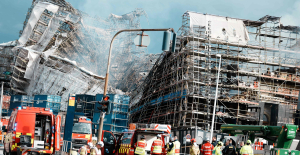As the Richard Spring Fire advanced through the Northern Cheyenne Indian Reserve, several thousand Montanans were still under evacuation orders.
California's Dixie Fire, which began July 13, threatened several small communities in northern Sierra Nevada. It was fueled by fire lines at its southern end.
The fire destroyed 790 square miles (2,200 kilometers) of land and destroyed 550 homes. It almost decimated Greenville last week. It was contained to 30%.
The Montana fire was fueled by hot temperatures and heavy winds. It spread quickly, torching trees and sending out embers that propelled flames across the landscape.
The fire started Sunday, and wind gusts of up to 56 mph (90 km/h) caused it explode over more than 260 miles (670 kilometers) by Thursday.
Angel Becker, spokesperson for the Northern Cheyenne Tribe, said that the fire is now within a mile (3.2 km) of Lame Deer's eastern edge. Officials said that the fire crossed a highway where officials had hoped it would be stopped late Wednesday. This put the southern part of the reservation at greater risk.
It closed in on the east end of the town, and a second fire was lit to the west. Tribal officials called for residents to leave the area late Wednesday night. Buses were brought in by tribal officials to transport people to Busby's school, which is approximately 15 miles (24 km) away, as well to the Crow Indian Reservation shelter.
Becker stated that while there were some who refused to leave, the majority of elders, women, and children left with that final push.
To keep the fire from destroying homes, firefighters worked on Thursday morning in the hills surrounding Lame Deer. Although no houses were destroyed, fire officials assessed the damage and found that more than a dozen sheds and other outbuildings were damaged.
Jimmy Peppers, Rancher, sat east of town on his horse and watched the orange glow grow close to his house.
Peppers said that he didn't believe the cattle would cross the highway, so he didn't move any of his farm equipment. He spent the afternoon moving his cattle to a pasture near town. "I don’t know if it will have a home in the morning."
This town, which is home to approximately 2,000 people, is surrounded by rugged, steep-leaf forest.
Krystal Two Bulls, along with some friends, stayed a few miles away from the town to clear brush from her backyard in an effort to protect it from the flames. From the ridgeline, which was tree-covered, thick plumes of smoke rose just above the house.
Two Bull stated, "We have everything we need so that if we have the need to travel, we will." "I don't fear; I'm prepared. You don't have to run away from fire or abandon your home.
About 600 people living in Ashland (a small town located just outside of the reservation) were also ordered to leave. Ranchers used their heavy equipment to create fire lines around homes with the help of local, state and federal firefighters.
Although Ashland was still under evacuation orders, officials stated that the danger seemed to have subsided for now.
Jenny Garcin, fire spokesperson, stated that crews were creating a firebreak around Lame Deer. They also used heavy equipment to make strategic, intentional burns in an effort to reduce the fuel on the ground.
According to the National Weather Service, Thursday's weather forecast in southeastern Montana was for cooler weather and less wind. This could provide temporary relief for firefighters before a ridge containing high pressure moves through the region and raises temperatures to the 90s over weekend.
Many Western states have been left with extreme drought conditions that have rendered trees, grass, and brush dry, making them ready for ignition. According to the National Interagency Fire Center, Montana had 25 wildfires.
California and other states were also facing monsoonal moisture flows that were too high for real rain, but could cause thunderstorms that can bring lightning strikes and erratic winds.
Three national forests in Northern California closed the Trinity Alps wilderness area, a 780-square-mile (2,000-kilometer) area of granite peaks and lakes, due to wildfires.
Tracking hikers in dangerous areas takes much-needed aircraft from firefighting efforts and increases risk for first responders. Forest managers also hope to reduce the risk of human-caused fires by this temporary complete closure," Shasta Trinity National Forest officials stated in a statement.
Scientists believe climate change has made the region warmer and drier over the past 30 years. This will continue to increase extreme weather and make wildfires more destructive and frequent. As Europe is also experiencing large wildfires, the more than 100 wildfires that have erupted in the American West are a sign of this.

 Sydney: Assyrian bishop stabbed, conservative TikToker outspoken on Islam
Sydney: Assyrian bishop stabbed, conservative TikToker outspoken on Islam Torrential rains in Dubai: “The event is so intense that we cannot find analogues in our databases”
Torrential rains in Dubai: “The event is so intense that we cannot find analogues in our databases” Rishi Sunak wants a tobacco-free UK
Rishi Sunak wants a tobacco-free UK In Africa, the number of millionaires will boom over the next ten years
In Africa, the number of millionaires will boom over the next ten years WHO concerned about spread of H5N1 avian flu to new species, including humans
WHO concerned about spread of H5N1 avian flu to new species, including humans New generation mosquito nets prove much more effective against malaria
New generation mosquito nets prove much more effective against malaria Covid-19: everything you need to know about the new vaccination campaign which is starting
Covid-19: everything you need to know about the new vaccination campaign which is starting The best laptops of the moment boast artificial intelligence
The best laptops of the moment boast artificial intelligence Bitcoin halving: what will the planned reduction in emissions from the queen of cryptos change?
Bitcoin halving: what will the planned reduction in emissions from the queen of cryptos change? The Flink home shopping delivery platform will be liquidated in France
The Flink home shopping delivery platform will be liquidated in France Bercy threatens to veto the sale of Biogaran (Servier) to an Indian industrialist
Bercy threatens to veto the sale of Biogaran (Servier) to an Indian industrialist Switch or signaling breakdown, operating incident or catenaries... Do you speak the language of RATP and SNCF?
Switch or signaling breakdown, operating incident or catenaries... Do you speak the language of RATP and SNCF? The main facade of the old Copenhagen Stock Exchange collapsed, two days after the fire started
The main facade of the old Copenhagen Stock Exchange collapsed, two days after the fire started Alain Delon decorated by Ukraine for his support in the conflict against Russia
Alain Delon decorated by Ukraine for his support in the conflict against Russia Who’s Who launches the first edition of its literary prize
Who’s Who launches the first edition of its literary prize Sylvain Amic appointed to the Musée d’Orsay to replace Christophe Leribault
Sylvain Amic appointed to the Musée d’Orsay to replace Christophe Leribault Skoda Kodiaq 2024: a 'beast' plug-in hybrid SUV
Skoda Kodiaq 2024: a 'beast' plug-in hybrid SUV Tesla launches a new Model Y with 600 km of autonomy at a "more accessible price"
Tesla launches a new Model Y with 600 km of autonomy at a "more accessible price" The 10 best-selling cars in March 2024 in Spain: sales fall due to Easter
The 10 best-selling cars in March 2024 in Spain: sales fall due to Easter A private jet company buys more than 100 flying cars
A private jet company buys more than 100 flying cars This is how housing prices have changed in Spain in the last decade
This is how housing prices have changed in Spain in the last decade The home mortgage firm drops 10% in January and interest soars to 3.46%
The home mortgage firm drops 10% in January and interest soars to 3.46% The jewel of the Rocío de Nagüeles urbanization: a dream villa in Marbella
The jewel of the Rocío de Nagüeles urbanization: a dream villa in Marbella Rental prices grow by 7.3% in February: where does it go up and where does it go down?
Rental prices grow by 7.3% in February: where does it go up and where does it go down? With the promise of a “real burst of authority”, Gabriel Attal provokes the ire of the opposition
With the promise of a “real burst of authority”, Gabriel Attal provokes the ire of the opposition Europeans: the schedule of debates to follow between now and June 9
Europeans: the schedule of debates to follow between now and June 9 Europeans: “In France, there is a left and there is a right,” assures Bellamy
Europeans: “In France, there is a left and there is a right,” assures Bellamy During the night of the economy, the right points out the budgetary flaws of the macronie
During the night of the economy, the right points out the budgetary flaws of the macronie These French cities that will boycott the World Cup in Qatar
These French cities that will boycott the World Cup in Qatar Europa Conference League: the semi-final flies to Lille, which loses to the wire against Aston Villa
Europa Conference League: the semi-final flies to Lille, which loses to the wire against Aston Villa Lille-Aston Villa: Cash disgusts Lille, the arbitration too... The tops and the flops
Lille-Aston Villa: Cash disgusts Lille, the arbitration too... The tops and the flops Handball: Les Bleues in the same group as Spain at Euro 2024
Handball: Les Bleues in the same group as Spain at Euro 2024 Europa Conference League: for Létang, Martinez “does not have the attitude of a high-level athlete”
Europa Conference League: for Létang, Martinez “does not have the attitude of a high-level athlete”


















